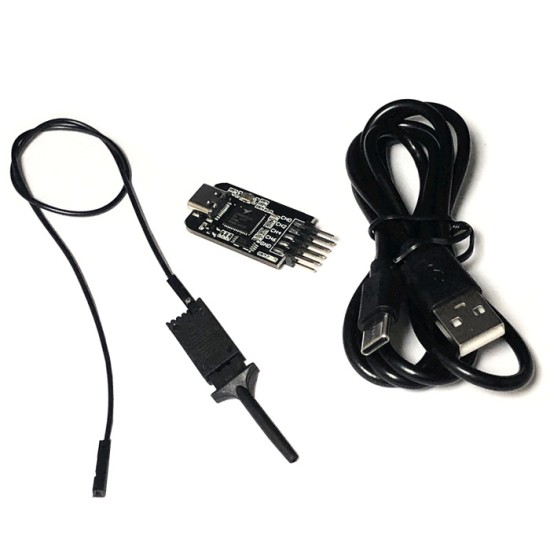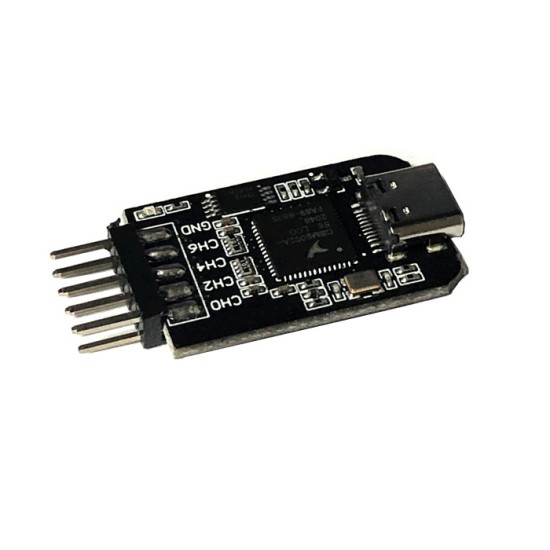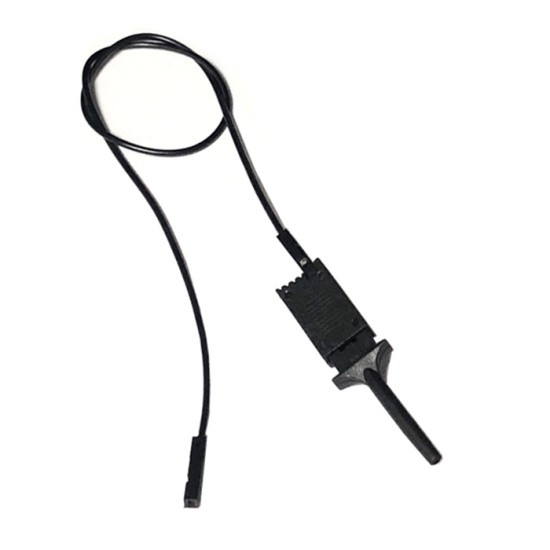







Mini logic analyzer Type C interface single -chip microcomputer ARM FPGA debugging tool 24M sampling 8 channels
Note: Shipping with transparent thermal contraction tube insulation protection. This model is only different from the USB-A port version. The functions are completely consistent.
User manual: https://github.com/wuxx/nanodla/blob/master/readme.md
Upper machine link: https://github.com/wuxx/nanodla/tree/master/software or Baidu web disk
https://pan.baidu.com/s/1ptjv2w0u9enJRU9TGRB00G extract code: A7C9
Support protocol: https://github.com/wuxx/nanodla/blob/master/decoder_list.md
This module is a logical analyzer of hardware software and the open source of the upper aircraft. The appearance is exquisite, small, rich in function, low in price, up to 24MHz sampling rate, and support more than 100 protocol analysis.It can better meet the daily development and commissioning needs of electronic engineers. In terms of problem positioning, complex systems of multi -component, timing analysis, performance analysis and other scenarios, development efficiency can be greatly improved.
Features
Hardware open source, provides hardware schematic diagrams, welcome to make electronic enthusiasts by themselves
Software open source, provides firmware source code, you can compile the firmware by yourself
The open source of the upper machine, the current logical analyzer on the market, generally uses cracking upper machine software. There are some legal risks in use. NANODLA relies on the SIGROK open source community to use the open source Pulseview upper machine, which is rich in functions and supports more than 100 kinds of protocol analysis.Free and open source, easy to use and stronger function
Support maximum 24mHz sampling rate, 8 channels can be sampling at the same time, which can meet daily development work and use
Expenditure input voltage [-0.5V, 5.25V], of which the low level is [-0.5V, 0.8V], the high level is [2V, 5.25V]
Support Windows/Linux/Mac/Android platform
Software installation and use
Before using NanoDLA normally, you need to manually install the driver for it to be recognized by PulseView. Just install the PulseView first, and then use the Zadig tool that comes with PulseView to install the driver. The specific steps are as follows.
PulseView installation
The Software directory of this warehouse contains the PulseView installation of the executable file. Just double -click the installation file and click the next step to install it. I won't go into details here.
Driver installation
Search Zadig and open in the starting column
选择Options->List all devices, the top of the FX2LAFW (USB ID is 1D50: 608C) corresponding to NANODLA, select WINUSB driver in the drive bar below, and click Install Driver to install the driver. After a while, you can successfully install the driver.
After the driver is successfully installed, the device can be identified normally
PulseView use
Insert nanodla into the PC, and then open the PulseView. After the pulseView starts, it will automatically search and open the FX2LAFW device. As shown in the figure
PulseView is relatively simple to use. In the menu bar below, configure the sampling data size and sampling rate. Click the RUN button in the upper left corner to start sampling. For NANODLA, the maximum sampling rate of 24MHz can be configured to work.
Protocol analysis
PulseView supports more than 100 kinds of protocol analysis. After the samples are sampled, click the menu bar protocol analysis icon, select specific protocols in the right window, click the protocol on the left, and configure the protocol. For example, the following is an analysis UARTExamples, you need to configure the Potter rate of UART, the data of the data, the stop bit, etc. After configured, the PulseView can analyze the visual data for analysis.
User manual: https://github.com/wuxx/nanodla/blob/master/readme.md
Upper machine link: https://github.com/wuxx/nanodla/tree/master/software or Baidu web disk
https://pan.baidu.com/s/1ptjv2w0u9enJRU9TGRB00G extract code: A7C9
Support protocol: https://github.com/wuxx/nanodla/blob/master/decoder_list.md
This module is a logical analyzer of hardware software and the open source of the upper aircraft. The appearance is exquisite, small, rich in function, low in price, up to 24MHz sampling rate, and support more than 100 protocol analysis.It can better meet the daily development and commissioning needs of electronic engineers. In terms of problem positioning, complex systems of multi -component, timing analysis, performance analysis and other scenarios, development efficiency can be greatly improved.
Features
Hardware open source, provides hardware schematic diagrams, welcome to make electronic enthusiasts by themselves
Software open source, provides firmware source code, you can compile the firmware by yourself
The open source of the upper machine, the current logical analyzer on the market, generally uses cracking upper machine software. There are some legal risks in use. NANODLA relies on the SIGROK open source community to use the open source Pulseview upper machine, which is rich in functions and supports more than 100 kinds of protocol analysis.Free and open source, easy to use and stronger function
Support maximum 24mHz sampling rate, 8 channels can be sampling at the same time, which can meet daily development work and use
Expenditure input voltage [-0.5V, 5.25V], of which the low level is [-0.5V, 0.8V], the high level is [2V, 5.25V]
Support Windows/Linux/Mac/Android platform
Software installation and use
Before using NanoDLA normally, you need to manually install the driver for it to be recognized by PulseView. Just install the PulseView first, and then use the Zadig tool that comes with PulseView to install the driver. The specific steps are as follows.
PulseView installation
The Software directory of this warehouse contains the PulseView installation of the executable file. Just double -click the installation file and click the next step to install it. I won't go into details here.
Driver installation
Search Zadig and open in the starting column
选择Options->List all devices, the top of the FX2LAFW (USB ID is 1D50: 608C) corresponding to NANODLA, select WINUSB driver in the drive bar below, and click Install Driver to install the driver. After a while, you can successfully install the driver.
After the driver is successfully installed, the device can be identified normally
PulseView use
Insert nanodla into the PC, and then open the PulseView. After the pulseView starts, it will automatically search and open the FX2LAFW device. As shown in the figure
PulseView is relatively simple to use. In the menu bar below, configure the sampling data size and sampling rate. Click the RUN button in the upper left corner to start sampling. For NANODLA, the maximum sampling rate of 24MHz can be configured to work.
Protocol analysis
PulseView supports more than 100 kinds of protocol analysis. After the samples are sampled, click the menu bar protocol analysis icon, select specific protocols in the right window, click the protocol on the left, and configure the protocol. For example, the following is an analysis UARTExamples, you need to configure the Potter rate of UART, the data of the data, the stop bit, etc. After configured, the PulseView can analyze the visual data for analysis.
| Product Attributes | |
| Brand | Other/Other |
| Goods number | F75 m3 A29 |
| Model | Other/Other |
Unlimited Blocks, Tabs or Accordions with any HTML content can be assigned to any individual product or to certain groups of products, like entire categories, brands, products with specific options, attributes, price range, etc. You can indicate any criteria via the advanced product assignment mechanism and only those products matching your criteria will display the modules.
Also, any module can be selectively activated per device (desktop/tablet/phone), customer login status and other criteria. Imagine the possibilities.
$0.25
- Stock: In Stock
- Model: ULDS1156
- Weight: 0.10kg



